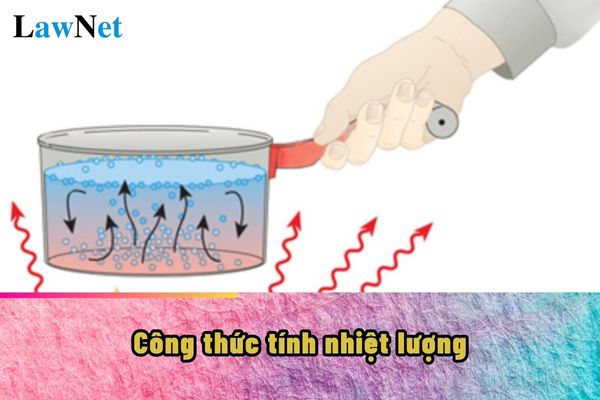What is the formula for calculating heat energy? What are regulations on the content of the Physics subject in the new curriculum in Vietnam?
What is the formula for calculating heat energy?
The formula for calculating heat energy is used to determine the amount of heat required to change the temperature of an object.
|
The formula is as follows: Q = m * c * Δt *Where: |
*Note: Information is for reference purposes only./.

What is the formula for calculating heat energy? What are regulations on the content of the Physics subject in the new curriculum in Vietnam? (Image from the Internet)
What are the specific competency requirements for students learning Physics in Vietnam?
In Section 4 of the General Education Curriculum for Physics, issued together with Circular 32/2018/TT-BGDDT, the Physics subject forms and develops in students the competency of physics, with specific manifestations as follows:
(1) Physics Cognition
Cognize the core knowledge and skills in physics, such as: physical system models; energy and waves; forces and fields; recognize some professions related to physics; manifesting specifically:
- Identify and articulate objects, concepts, phenomena, physical laws, and processes.
- Present physical phenomena and processes; describe the characteristics and roles of these phenomena and processes using various forms of expression: speaking, writing, measuring, calculating, drawing, diagramming, charting.
- Identify keywords, utilize scientific terminology, logically connect information meaningfully, and draft outlines when reading and presenting scientific texts.
- Compare, select, categorize, and analyze physical phenomena and processes based on different criteria.
- Explain the relationships between objects, phenomena, and processes.
- Recognize mistakes and revise perceptions or explanations; make critical judgments related to the discussion topic.
- Recognize some professions suitable for one's inclinations.
(2) Exploring the natural world from a physics perspective
Explore some simple, familiar physical phenomena and processes in life and in the natural world; using scientific evidence to test predictions, explain evidence, and draw conclusions; manifesting specifically:
- Propose physics-related issues: Recognize and formulate questions related to the problem; analyze contexts to propose issues by connecting existing knowledge and experiences, using their own language to express the proposed issue.
- Make predictions and construct hypotheses: Analyze the issue to make predictions; construct and articulate hypotheses to be explored.
- Plan implementation: Establish a logical framework for exploration; choose suitable methods (observation, experimentation, investigation, interviews, literature review); plan the exploration.
- Execute the plan: Collect and store data from summary, experimentation, and investigation results; evaluate outcomes based on analyzing and processing data using simple statistical parameters; compare results with hypotheses; explain, conclude, and adjust when necessary.
- Write and present reports, and discuss: Use language, drawings, diagrams, and tables to express the exploration process and results; write reports post-exploration; engage cooperatively with partners with a positive attitude and respect for viewpoints and evaluations from others, to actively absorb and explain, argue, and defend exploration results convincingly.
- Make decisions and propose opinions, solutions: Make decisions for problem solving; propose recommendations to apply exploration and research results, or suggest further research issues.
(3) Applying acquired knowledge and skills
Apply acquired knowledge and skills in some simple cases, initially using mathematics as a language and tool to solve problems; manifesting specifically:
- Explain and prove a practical issue.
- Evaluate and critique the impact of a practical issue.
- Design models, create plans, propose and implement some new methods or measures.
- State solutions and implement solutions to protect nature, adapt to climate change; behave and hold attitudes that promote sustainable development.
In the Physics Curriculum, each element of the general and specific competencies mentioned is integrated into each topic and content strand, in the form of requirements with varying levels of achievement.
What are regulations on the content of the Physics subject in the new curriculum in Vietnam?
In Section 5 of the General Education Curriculum for Physics, issued together with Circular 32/2018/TT-BGDDT, the content of the Physics subject in the new curriculum in Vietnam is as follows:
| Content Strand | Grade 10 | Grade 11 | Grade 12 | Note |
| Introduction | x | |||
| Physics in certain professions | x | Topic 10.1 | ||
| Kinematics | x | |||
| Dynamics | x | |||
| Work, energy, power | x | |||
| Momentum | x | |||
| Circular motion | x | |||
| Deformation of solids | x | |||
| Earth and sky | x | Topic 10.2 | ||
| Physics with environmental protection education | x | Topic 10.3 | ||
| Gravitational field | x | Topic 11.1 | ||
| Oscillations | x | |||
| Waves | x | |||
| Information transmission by radio waves | x | Topic 11.2 | ||
| Electric field | x | |||
| Electric current, circuits | x | |||
| Introduction to electronics | x | Topic 11.3 | ||
| Thermal physics | x | |||
| Ideal gas | x | |||
| Magnetic field | x | |||
| Alternating current | x | Topic 12.1 | ||
| Nuclear physics and radioactivity | x | |||
| Some applications of physics in medical diagnostics | x | Topic 12.2 | ||
| Quantum physics | x | Topic 12.3 |

